Features
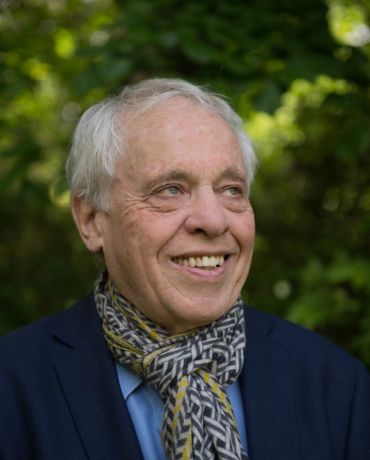 Professor Joe Silk. Image credit: Joe Silk.
Professor Joe Silk. Image credit: Joe Silk.
He is currently an Emeritus Fellow of New College, a fellow of the American Academy of Arts and Sciences, the American Physical Society, the Institute of Physics, the Royal Society and the US National Academy of Sciences. Besides authoring more than 900 academic publications, he has written several popular books including ‘The Big Bang’, ‘The Infinite Cosmos’, ‘On the Shores of the Unknown: A Short History of the Universe’, and ‘Cosmic Enigmas.’
Despite having received multiple lifetime achievement awards, Professor Silk shows no sign of slowing down yet. His latest book ‘Back to the Moon: The Next Giant Leap for Humankind’ was published in November 2022. He talks about his career to date, and how returning to the Moon could help us uncover our cosmic origins.
In your latest book 'Back to the Moon' you argue that returning to the Moon could open up a ‘thrilling new age of scientific exploration.’ Please can you explain this?
The answer to that really goes back to the question that has driven my entire career: What is the underlying structure of the Universe and where did it come from?
We know that the Universe started as a relatively homogenous, smooth and dense distribution of mass that eventually developed into what we see today, with galaxies, stars, planets, and so on. Cosmologists such as myself are intensely interested in that evolutionary process, which we study using powerful telescopes. Quite literally, these enable us to see back in time – but not quite as far as we would like to. To see back before there were any galaxies, before there was any light, that’s our greatest challenge. We can only do that with radio waves that can probe the gas clouds of atomic hydrogen from which all galaxies assembled.
It’s essentially impossible from the Earth because we need to look in really low radio frequencies to see back this far. But on the far side of the Moon, conditions are unbelievably well optimised for probing the dark ages of the Universe, before the first galaxies formed. It is this epoch that holds clues to our cosmic beginnings.
What do we understand at the moment?
The furthest back we can see in time is the cosmic microwave background (CMB) radiation, dating from 400,000 years after the Big Bang, long before there were any galaxies or stars. Basically, the CMB is the cooled remnant of the first light to travel freely through the Universe, and we experience it as a radio signal that originates from every point in the sky. At first, this signal appeared to be completely uniform, but with highly precise telescopes we eventually detected small variations. These correspond to tiny fluctuations in temperature, caused by ‘ripples’ in the underlying structure. These ripples get stronger over time, until gravity eventually pulls them together to develop into gas clouds and then galaxies.
We are now beginning to capture this phenomenon using large microwave telescopes in space and in remote areas on Earth. We glimpse the seeds. But I want to study how these seeds assembled into galaxies. I need to go back in time to before there were any galaxies, to see their building blocks. To see the wisps of hydrogen gas from which galaxies assembled. To learn where these irregularities came from in the first place – to go right back to the ‘dark ages’ before there was any light at all.
If we could see further back in time, what could this tell us?
Our current best theory is that the Universe began as highly dense matter, then went through a dramatic period of inflation in a fraction of a second to reach its current proportions. From this remote origin, we believe that the ripples we see in the CMB today were created from tiny, high-energy quantum fluctuations that expanded during the end of the inflationary phase into cosmological proportions. If we could see back far enough to probe these fluctuations, this glimpse into the darkness could verify that inflation occurred during the first quadrillionth of a nano-second of the Universe’s existence.
 A map produced by the European Space Agency (ESA)'s Planck satellite (2009-2013) showing slight temperature differences across the Cosmic Microwave Background, CMB. Image credit: ESA/Planck Collaboration.
A map produced by the European Space Agency (ESA)'s Planck satellite (2009-2013) showing slight temperature differences across the Cosmic Microwave Background, CMB. Image credit: ESA/Planck Collaboration.So, where does the Moon come into this?
We can’t see into the dark ages on Earth because a layer of ionized gas in our atmosphere acts as a surrounding blanket. The atmosphere is a good thing for life, but its ionosphere layer scatters low frequency radio wave signals. These are the ultimate messengers from the dark ages. In theory, the best place to set up a low frequency radio telescope would be in outer space, but this is extremely difficult for practical reasons. And even there we would be subject to radio interference from the Earth.
A more realistic prospect is the far side of the Moon. Because the Moon has no ionosphere, in terms of radio interference it is probably one of the quietest places in the inner solar system. And the far side of the Moon is shielded from all the radio waves coming from Earth, from mobile phone masts and maritime radar, for instance. It’s a stable platform where we could build incredibly large telescopes.
To be clear, this is a very long-term project that is only just beginning to undergo design studies. It could take anywhere between 10 and 30 years before these experiments come to fruition. But the journey is beginning, and even in the next few years we expect to be launching the first pathfinder projects to the far side of the Moon.
Besides mining, I envisage that the Moon will become a hub for lunar tourism and even interplanetary travel. Within its craters, there are huge resources of ice and water that could provide a source of hydrogen and oxygen for energy and rocket fuel. And because the Moon has a much lower gravity than Earth, it would make a great place to build a spaceport for rocket launches.
Are there other reasons we should go back to the Moon – for instance, to mine critical elements?
It is true that we are running out of semiconductor and rare earth materials that are critical for technologies such as computers and wind turbines. The Moon is a prime target for future mining expeditions because it is many thousands of times richer in these resources than Earth. This is due to its surface having been bombarded over billions of years by meteorites that have deposited layers of rare materials on its surface.
Besides mining, I envisage that the Moon will become a hub for lunar tourism and even interplanetary travel. Within its craters, there are huge resources of ice and water that could provide a source of hydrogen and oxygen for energy and rocket fuel. And because the Moon has a much lower gravity than Earth, it would make a great place to build a spaceport for rocket launches. The first step is likely to be NASA’s Artemis programme which envisages launches from a lunar space station, following the return of astronauts to the lunar surface within three or four years from now.
Apart from lunar exploration, what else are you researching at the moment?
What is the nature of the dark matter? That’s one of the greatest puzzles in astrophysics. Dark matter is the dominant form of matter in galaxies, and indeed in the Universe. Yet it is not the ordinary matter that stars are made of, and only interacts very weakly with ordinary matter. Most likely it consists of an as yet undiscovered elementary particle. I have proposed ingenious techniques for detecting such particles. For example, dark matter particles may interact with themselves. They can annihilate or decay, and produce electromagnetic signals that are potentially detectable, such as gamma rays.
There is a mysterious excess of gamma radiation from the centre of the Milky Way galaxy. That’s where the density of dark matter is highest. Perhaps this is a signal from dark matter, or perhaps it’s the cumulative emission from astrophysical sources such as a large abundance of rapidly spinning old neutron stars, which are known to be weak gamma ray sources. We don’t know and are seeking other tests, such as examining nearby dwarf galaxies, known repositories of dark matter. So far, the jury is out.
 Artist impression of activities in a Moon Base. Power generation from solar cells, food production in greenhouses and construction using mobile 3D printer-rovers. Image credit: ESA / P. Carril.
Artist impression of activities in a Moon Base. Power generation from solar cells, food production in greenhouses and construction using mobile 3D printer-rovers. Image credit: ESA / P. Carril.You were appointed as the University of Oxford’s Savilian Professor of Astronomy (from 1999 to September 2011), one of Oxford's oldest chair positions, founded in 1619. What were your key achievements in this role?
Oxford has a very illustrious past for astronomy, most notably the discovery around 1705 by Savilian Professor Edmond Halley in an attic observatory on New College Lane of the periodic appearances of the comet now named after him. But when I arrived some three and a half centuries later, the Savilian chair had somewhat lost its momentum in its impact on Oxford astronomy. I am proud of the role I played to drive cosmology forward, in particular by developing several major research themes in surveying distant galaxies, galaxy formation, and the nature of gravity.
During my period of leadership, I oversaw the appointments of several young researchers who have since evolved into international leaders in their various fields of research. I founded the Beecroft Institute for Particle Astrophysics and Cosmology in 2003, now a thriving hub of cosmology research. For instance, one of the leading numerical simulations of the Universe was developed at Oxford, and is now widely used to understand how the diverse properties of galaxies are generated. Another achievement was exploring alternatives to Einstein’s theory of gravity to monitor the relevance of challenges to our canonical model of structure formation, the cold dark matter theory, and to tensions in our measures of the rate at which the Universe is expanding.
I need to go back in time to before there were any galaxies, to see their building blocks. To see the wisps of hydrogen gas from which galaxies assembled. To learn where these irregularities came from in the first place – to go right back to the ‘dark ages’ before there was any light at all.
You have authored over 900 publications; which one are you most proud of?
This would have to be one of my first papers, ‘Fluctuations in the primordial fireball’, published in Nature in 1967. In this short paper, I predicted the presence of primordial temperature fluctuations in the CMB. I argued that tiny seeds, overdensities or underdensities in the intensity of radiation, had to be present at the beginning of time, as otherwise Einstein’s theory of gravity could not adequately explain galaxy formation. Detection would be a crucial test of gravitational theory and of the Big Bang itself. It took a very long time, around 30 years, but eventually these temperature fluctuations were found – one of the proudest moments of my life!
Have you always been interested in outer space?
Not at all! I grew up in London, so only saw the stars on occasional camping trips with the Boy Scouts. I actually read mathematics as an undergraduate at the University of Cambridge. During my final year, I found that the prospect of becoming an actuary or something like that left me rather bored. So, when I was procrastinating instead of revising for my final exams, I started wandering around lectures for different subjects, sitting at the back so no one would notice my ‘unauthorised’ presence.
I stumbled across the charismatic cosmologist Dennis Sciama, whose lectures blew my mind away. He was explaining how Albert Einstein was himself inspired by Mach’s principle. Ernst Mach was a 19th century physicist/philosopher who argued that the inertia of our local reference frame is determined by the distant stars – or to put it more simply, that local physical laws are determined by the large-scale distribution of matter in the Universe. I realised that our amazing Universe was motivating very deep questions that really fired me up.
This led me to do a diploma course in Physics at Manchester University. There I did a research project with an eminent radio astronomer, Roger Jennison, one of the founders of radio interferometry. This went so well that it opened the way to a graduate fellowship provided by the precursor of what is now the European Space Agency. I chose Harvard University because I wanted to work with cosmologist David Layzer, whose specialty was the formation of structure in the expanding universe. I was fortunate that I began my PhD at Harvard just after the major discovery of the CMB, which opened up a completely new and unexplored territory in cosmology that has sustained almost my entire career.
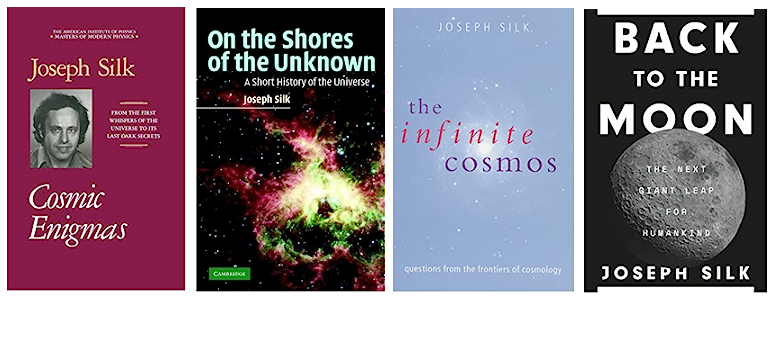 A selection of the popular science books authored by Professor Joe Silk.
A selection of the popular science books authored by Professor Joe Silk.Do you think there is life out there?
That is the question that will always capture the public’s imagination. It is an exciting time now that we can probe the atmospheres of distant planets for signatures that could be indicative of life: oxygen, chlorophyll, methane, etc. But there really are no guarantees. It is hard to even estimate the number of planets we would need to look at to make discovering extra-terrestrial life a likely probability. Life is fragile, and it is likely to be a rare phenomenon. And the number of Earth-like planets that are relatively close to us is very limited.
There is only one way to pursue this goal. To find large numbers of Earth-like twins, that is planets with rocky cores, an atmosphere, and close to stars like our sun, we need a very large telescope in space. Realistically, that could best be constructed on the Moon – giving us another reason to invest in lunar exploration.
What have been some of the most exciting technological advancements in cosmology during your career?
Certainly, the incredible rise in computational power and our ability now to make very detailed, precise computer simulations of all sorts of phenomena. In my early career work on galaxy formation, my ‘models’ were cartoons along with a few simple equations. Now, using powerful computers, we can make incredible simulations of galaxies that are almost indistinguishable from the real thing.
You have written several cosmology books for the general public. How important is it that the public are interested in space science?
I do believe that it is important to engage the public with our work, and not just because they pay our bills and fund our research. The beauty and mystery of space has an ability to inspire awe that few things can come close to. So, it is only right that we open up our notebooks to the general public, and explain the rationale behind our goals in answering the great questions of the Universe. In this way, we build up interest and momentum to keep up what we are doing.
You can learn more about Professor Silk’s work in a series of video talks: The Physics of Fine-Tuning. These discuss how the laws of physics, the initial conditions of the universe, and features of our local world work together to produce the world we live in.
Glossary:
Dark matter: A proposed component of the Universe which cannot be seen because it does not absorb, reflect, or emit electromagnetic radiation. Its presence can only be inferred from its gravitational attraction on visible matter. Dark matter is thought to account for around 27% of the Universe; the rest is dark energy (68%) and normal visible matter (5%).
Professor Sir Peter Horby, Director of Oxford’s Pandemic Sciences Institute, explains how building relationships across scientific disciplines, sectors and global regions are key to preventing and preparing for future pandemics.
The COVID-19 pandemic changed the world. Nowhere was left untouched, from bereaved families to personal freedoms and global economies.
But it also changed the interaction between science and the public in a way that caught some by surprise. Scientists who had previously existed in a world of research and academia were suddenly thrust into the public eye and being asked to provide solutions for a frightening and fast-moving global crisis.
We have learned a lot from the pandemic, not only about how diseases like COVID spread but also about our own capability and capacity to respond.
The rapid development of the Oxford AstraZeneca COVID vaccine, diagnostic tests, the RECOVERY trial, and contact tracing apps were only possible because of our extensive partnerships with other researchers, as well as with healthcare providers and industry partners across the UK and internationally. It was these existing relationships, as well as the significant depth of our prior research into diseases like MERS, Ebola and influenza, that made such fast development of responses to COVID possible.
This week the Pandemic Sciences Institute held its first annual International Pandemic Sciences Conference here in Oxford, where we welcomed more than 450 participants from 40 countries, representing scientists, ethicists, industry partners and funders who were deeply involved in developing the new approaches that were rapidly developed and deployed during the pandemic.
Getting people together to share the latest scientific breakthroughs is important, but just as crucial is providing an opportunity for people to meet face-to-face and build relationships. These relationships are the glue that will make the global response to the next pandemic faster, more efficient and more cohesive.
The theme of the conference was ‘Making the Exceptional Routine’, which was to emphasise the fact that there is no room for complacency about future epidemic and pandemic threats. It is important that we continue to learn from one another and ensure that the exceptional ways of working that we developed quickly and under pressure over the past few years can become the new business as usual in pandemic sciences.
For the Pandemic Sciences Institute this means not only generating new understanding but also translating this knowledge into practical, real-world interventions such as diagnostics, vaccines and medicines. It also means considering the social, ethical and policy dimensions from the outset to ensure pandemic responses are acceptable, equitable and minimally disruptive.
With sufficient determination and resources, we know we can radically accelerate the development and implementation of interventions that benefit humanity. But it is vitally important that we ensure that while encouraging academic excellence we also foster equitable partnerships to safeguard health and economic stability for future generations in every part of our world.
Watch video highlights of the International Pandemic Sciences Conference.
In the summer of 2022, a ten-strong team of Oxford graduate students travelled to Tenerife, four of whom worked on a project to investigate food waste in hotels and holiday resorts on the Spanish island, as part of the easyJet holidays Sustainable Tourism Programme.
A collaboration between Oxford University’s SDG (Sustainable Development Goals) Impact Lab and easyJet holidays, the programme enables Oxford students to work alongside businesses to identify and deliver solutions that help develop sustainable travel. Reducing food waste is a global concern identified in the United Nations (UN) SDGs and is considered the third most promising solution to address climate change.
Just 10 months on, the work of these ‘SDG Impact Lab Fellows’ is having a tangible real-world impact following the UK-based tour operator’s unveiling of an initiative that will utilise the power of AI to reduce food waste and run more sustainable kitchens in destinations where it offers package holidays.
The project team was made up of a diverse group of Oxford students studying a range of subjects as varied as International Development and Archaeological Science, and from as far afield as South Africa and Bolivia. Over four weeks they undertook research to understand the scale of the issue of food waste in the island’s hotels and develop evidence-based solutions to tackle it.
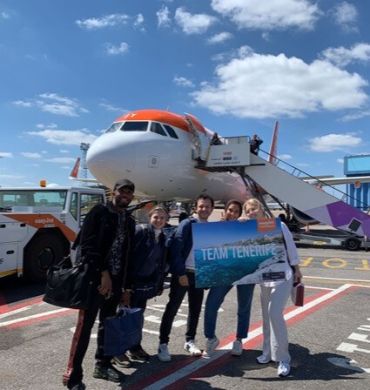 The SDG Impact Lab Fellows travelling to Tenerife to undertake research on sustainable tourism and food waste in the hospitality sector
The SDG Impact Lab Fellows travelling to Tenerife to undertake research on sustainable tourism and food waste in the hospitality sectorSDG Impact Lab Fellow, Laura Ballerini, a PhD Candidate in International Development, talks about how the team went about it: ‘We carried out mixed-method research and relied on a two-pronged approach. The first was a quantitative survey which we sent to a sample of 85 hotels in Tenerife to ascertain pre-existing approaches to sustainability and current food waste management mechanisms.
‘The second approach involved in-depth, semi-structured interviews with hotel directors, managers, and staff. These interviews aimed at gaining greater insights into the experiences and practices used by hotels to tackle food waste. Interviews were often accompanied by what we called ‘kitchen-based ethnography’, which essentially consisted of visits to hotel kitchens and long, informal conversations with chefs and kitchen staff.’
The team also engaged with a wide range of stakeholders with expertise in food waste, including leading researchers from local universities, public officials, private-sector experts, and representatives of local NGOs.
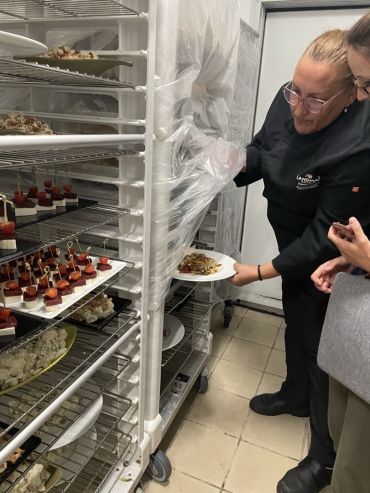 The team visited hotel kitchens to understand more about current food waste management practices
The team visited hotel kitchens to understand more about current food waste management practicesDesmond Okumbor, who completed the Lab Fellowship alongside an MSc in Politics Research, describes the value of key stakeholder engagement: ‘Presenting to stakeholders proved to be an informative and enlightening experience. During this process, we were afforded the opportunity to gain an in-depth understanding of the critical issues at hand, which in turn allowed us to effectively identify and evaluate potential areas where our contributions could provide substantial value.’
Their research revealed that 18% of food waste in Tenerife was generated by the hospitality sector alone and that most hotels on the island had limited to no measures in place to adequately quantify the amount of food waste they generated.
The team recommendation was a partnership with Winnow, a UK tech company, to provide AI solutions to enable hotels and resorts in Tenerife to measure and prevent food waste. They pitched their business case to easyJet holidays in July 2022.
 Laura (right) and Desmond (left) conducting interviews about sustainability and food waste with a hotel director (middle) in Tenerife.
Laura (right) and Desmond (left) conducting interviews about sustainability and food waste with a hotel director (middle) in Tenerife. Based on the Oxford team’s recommendations, easyJet holidays has now formed a first-of-its-kind partnership with Winnow for the launch of a pilot programme that will monitor the reduction of food waste at one of their most popular hotels, the Bahia Principe Sunlight Costa Adeje resort in Tenerife.
Using technology similar to that of driverless cars, Winnow’s AI tools learn to ‘see’ food being wasted through a connected terminal with a motion camera. Data is shared with hotel teams who receive reports that pinpoint waste, giving them the insight to make operational improvements. Typically, kitchens using this form of AI solution see food waste halved within 12-18 months.
Project team member Desmond Okumbor explains: ‘AI Winnow is a smart solution to food waste because it leverages AI technology to provide automated data collection, insights and recommendations, real-time feedback, and cost savings for businesses. By helping businesses to reduce their food waste, it can also contribute to reducing the environmental impact of food waste.’
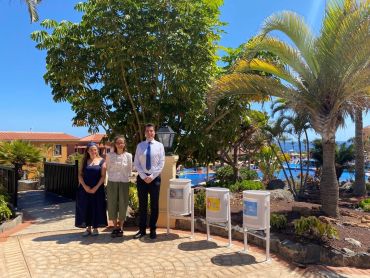 Ruby-Anne Birin (far left) and Laura (second from the left) and the Deputy Manager of the Bahia Principe Sunlight Costa Adeje resort
Ruby-Anne Birin (far left) and Laura (second from the left) and the Deputy Manager of the Bahia Principe Sunlight Costa Adeje resortLaura Ballerini, a PhD Candidate in International Development, said, ‘It was an immense joy to see that the research efforts my team put into unpacking the major issue of food waste informed the launch of a first-of-its-kind pilot programme with the potential to make a substantial, tangible impact!’
MPP+MBA student Diego Rojas-Arancibia reflects positively on his experience as a Lab Fellow: 'I had a great time working with eJh. We were able to lead our own research, and work on something that can achieve real impact. Moreover, without the field research, we would not have been able to understand hotels' needs. Having a combination of training and field research helped us not only to come up with a strong project, but also to learn different leadership skills’.
Following the successful outcome of the first year of the SDG Lab’s Sustainable Tourism Programme, a second cohort of Oxford students are undertaking Lab Fellowships to develop strategic and destination-based projects to help make easyJet holidays an industry leader in sustainable tourism.
Established in 2021, the SDG Impact Lab brings together the research expertise of Oxford University with partners across industry sectors, to address the most pressing challenges of our time. The Lab’s programmes enable talented graduate students to collaborate with non-academic partners to identify creative, interdisciplinary solutions that advance the UN SDGs.
Find out more about the SDG Impact Lab.
On World Malaria Day 2023, the global fight against malaria has hit a critical point in Africa. Recent studies have confirmed that malaria parasites resistant to artemisinin have emerged in Rwanda, Uganda and the Horn of Africa.
Artemisinin-based combination therapies (ACTs) are the first line treatment for malaria and there is no immediate replacement available. The loss of ACTs will put millions of Africans, mostly children under the age of 5, at risk of drug-resistant malaria infection and death.
One possible solution?
Adding a third drug to current ACT drug combinations. These Triple ACTs or TACTs have been found in clinical trials in Asia to be highly efficacious even in places where ACTs were failing.
'It is so much easier to prevent antimalarial drug resistance than to try and contain it. We are in danger losing of our current antimalarial drugs to resistance,' said Professor Sir Nick White, University of Oxford Professor of Tropical Medicine based at the Mahidol-Oxford Tropical Medicine Research Unit (MORU), in Bangkok.
'Triple artemisinin combination treatments [TACTs] will protect against resistance and help ensure that these drugs remain effective until new drugs arrive in 5-10 years time,' said Professor White.
Before TACTs can be widely deployed in Africa, however, their efficacy, safety and tolerability must be confirmed in African populations, especially children.
To that end, the Development of Triple Artemisinin-based Combination Therapies (DeTACT) trial is studying in eight African and two Asian countries two new TACTs - Artemether+lumefantrine+amodiaquine and Artesunate+piperaquine+mefloquine - to generate evidence that they are safe and effective malaria therapies.
The DeTACT project has also conducted modelling, ethics and market positioning studies to support their use in Africa and thereby prevent or delay the emergence of artemisinin and multi-drug resistant malaria.
'The DeTACT project aims to provide the necessary evidence that TACTs can both delay antimalarial drug resistance to existing drugs, and be an effective treatment for multidrug resistant infections. DeTACT will also deliver a product to market, and engage with national and global policy makers and stakeholders to discuss the potential position of TACTs in the mix of antimalarial drugs,' said University of Oxford Professor Arjen Dondorp, DeTACT project Principal Investigator.
Led by University of Oxford-affiliated researchers based at MORU in Bangkok, and funded by UK Aid administered through the Foreign, Commonwealth and Development Office (FCDO), the DeTACT trial has recruited over ~1800 patients as of April 2023 , with recruitment and follow-up completed in Niger and Nigeria, and no major or unexpected safety signals detected.
Once recruitment and follow-up are completed at the end of 2023, DeTACT investigators will present results in April 2024. Prior to that, they aim to present interim findings at a DeTACT symposium in October 2023 at the American Society of Tropical Medicine and Hygiene (ASTMH) 72nd Annual Meeting in Chicago, USA.
The first modelling study to project the impact of TACTs in preventing or delaying artemisinin resistance, led by Associate Professor Ricardo Aguas, University of Oxford, and Associate Professor Maciej Boni, Pennsylvania State University, has been completed and will soon be published in the prestigious journal, Nature Communications.
'These DeTACT modelling studies and market positioning studies generate data that will be crucial in our efforts to effectively introduce TACTS and to project the impact and cost-effectiveness of TACTs in preventing the spread of artemisinin resistance. Along with the clinical trial, these studies constitute a comprehensive assessment of the expected advantages and potential barriers to the large-scale use of TACTs,' explained Dr Chanaki Amaratunga, DeTACT Project Coordinator.
The DeTACT project has engaged malaria stakeholder engagement officers to communicate directly with National Malaria Control Programmes (NMCPs) to present to them to the DeTACT project and TACTs in general. Presentations on DeTACT and TACTs have been made at the RBM Partnership to End Malaria Case Management Working Group and the Seasonal Malaria Chemoprevention (SMC) Alliance Annual meetings. These efforts have led to significant interest from all parties in participating in future research and exploring the roll-out of TACTs in their countries.
To make TACTs available as quickly as possible where they are most needed it is critical to work with the pharmaceutical industry on the co-formulation. MORU has signed a memorandum of understanding with Fosun Pharma, China, and the Medicines for Malaria Venture (MMV) to develop and pre-qualify fixed-dose combinations of artemether-lumefantrine-amodiaquine, prior to deploying them across Africa.
'The DeTACT trial will generate data not only on the efficacy and safety of TACTs but also on the pharmacokinetics of each of the drug components, including in malnourished children – a particularly vulnerable sub-population. In addition, there will be cutting-edge analyses, combining clinical trial data with that from whole genome and transcriptome studies, to improve our understanding of artemisinin and antimalarial drug resistance,' said Dr Mehul Dhorda, DeTACT-Africa Coordinator.
Further reading
Market Formation in a Global Health Transition.
Triple Artemisinin-Based Combination Therapies for Malaria - A New Paradigm?
A statistical analysis of 650 UK spinouts between 2010 and 2021 shows that the university proportion of equity share has a limited effect on multiple fundraising factors including the probability of spinouts raising equity, the amount of funding raised, and the market valuation of a spinout after it has received funding.
The study, released last week by the Saïd Business School at the University of Oxford, provides a UK-wide analysis of UK spinouts where a university owns at least a 1% stake of founding equity.
The results speak for themselves, there are some specific effects but the broad-brush argument, that higher university stakes make spinouts unfundable, is not supported in the data.
Professor Thomas Hellmann
The paper’s lead author, Thomas Hellmann, DP World Professor of Entrepreneurship and Innovation at the Oxford Saïd Business School, said, ‘This often-heated debate about a university’s stake in their spinouts happens in a data vacuum, based on opinion and anecdote. We are addressing this gap by analysing systematic data on the relationship between university stakes and subsequent fundraising outcomes. The results speak for themselves, there are some specific effects but the broad-brush argument, that higher university stakes make spinouts unfundable, is not supported in the data.’
The paper entitled ‘How does equity allocation in university spinouts affect fundraising success? Evidence from the UK’ highlights that the average university equity share is 31% and declining, with the University of Oxford’s equity share at 20%, well below the UK average reported. The finding also suggest that the more resources available to university technology transfer offices to spend on registering IP, the higher the number of spinouts are created.
Oxford University Innovation’s CEO, Matt Perkins, said: ‘We welcome this timely UK-wide study and the rigour of the analysis. University Technology Transfer Offices provide tremendous support to create spinout companies by assessing market potential, registering and covering the costs of intellectual property, advising on investment options, and supporting the creation of management teams. We want to see sustained success for the spinouts created and have supported our founders by reducing the University’ founding equity share to 20%, speeding up the creation of companies and reducing the burden of negotiation.'
We remain committed to foster innovation and entrepreneurship to maximise the global impact of the University’s research and expertise and have delivered this through recently reaching a milestone of 300 companies created.
Matt Perkins, Oxford University Innovation
The analysis highlights that less than five per cent of university spinouts in the UK ever raise more than £25 million. This data suggests the debate should focus less on equity share and more on creating more attractive investment opportunities for UK spin outs to scale up exponentially.
The study shows there is no statistically significant impact of a university’s share on venture capital investment in biomedical and engineering spinouts. It highlights a very minimal negative effect of university share on the probability of raising venture capital in less scientific spinout sectors such as IT.
Professor Chas Bountra, Pro-Vice-Chancellor for Innovation at the University of Oxford said: ‘Oxford remains at the forefront of the UK’s university innovation economy thanks to our researchers and the commercialisation potential of their work. We continue to contribute to the UK’s innovation economy by reinvesting our university returns into funding further research innovation and by aligning our commercialisation approaches with our founders and partners in industry, the investment community, government, and the wider ecosystem.'
Growth of University of Oxford spinouts, 1959 - 2022
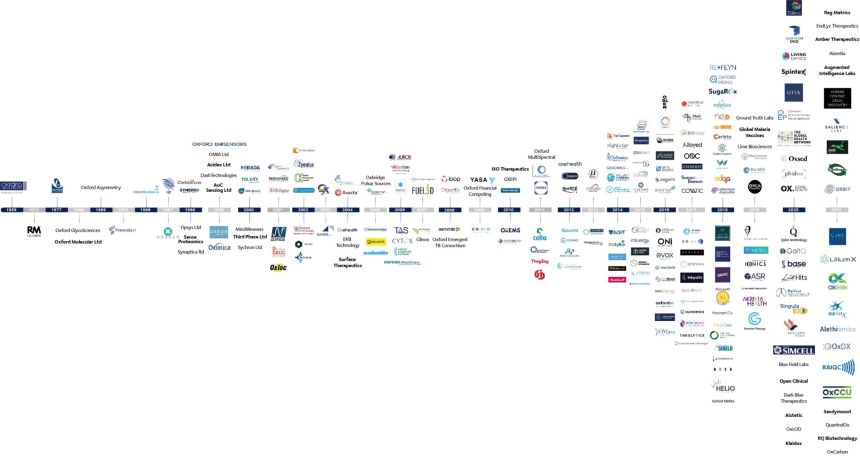 Growth of Oxford's spinouts, 1959 - 2022
Growth of Oxford's spinouts, 1959 - 2022- ‹ previous
- 5 of 247
- next ›
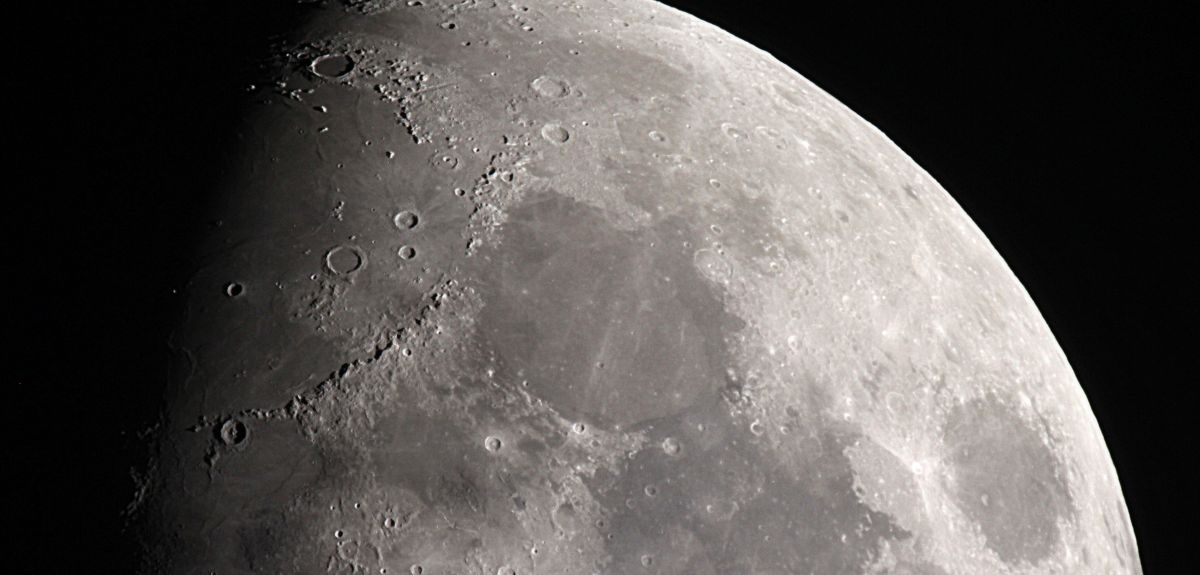
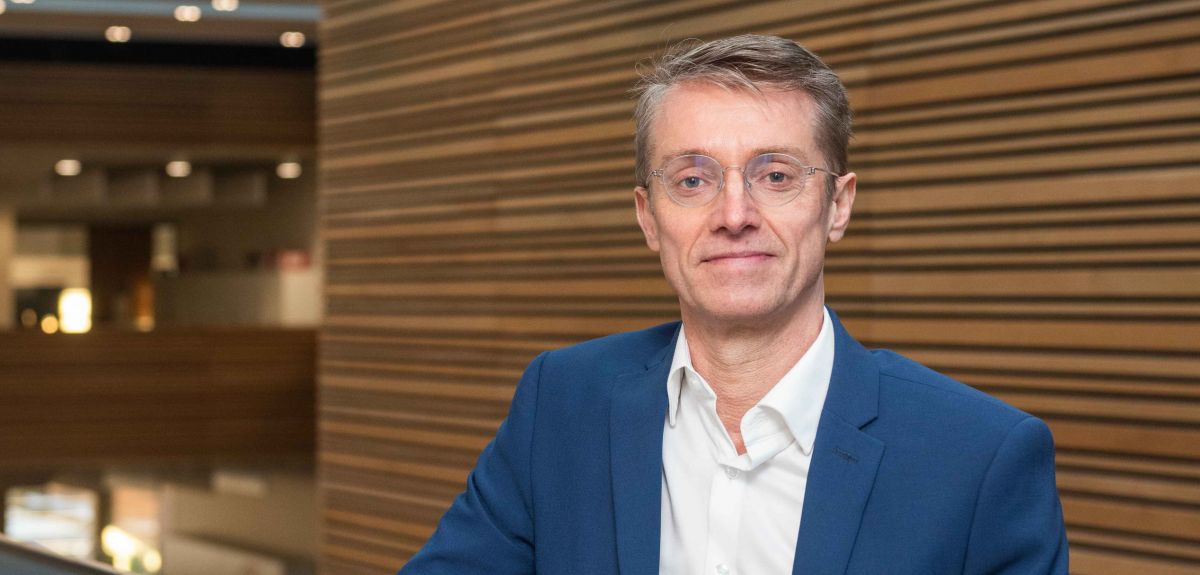
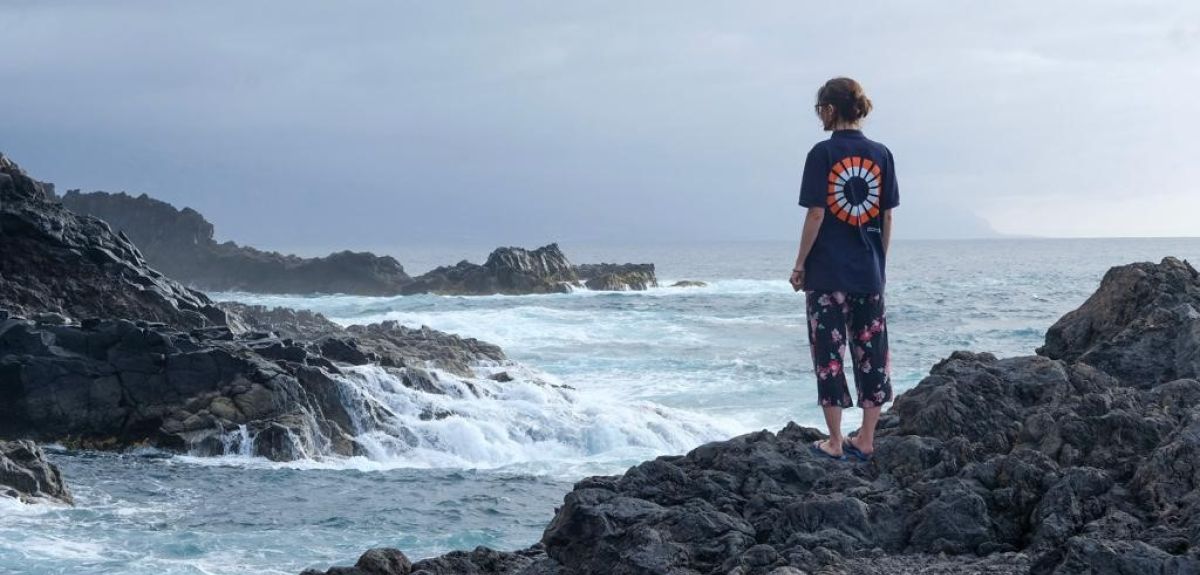
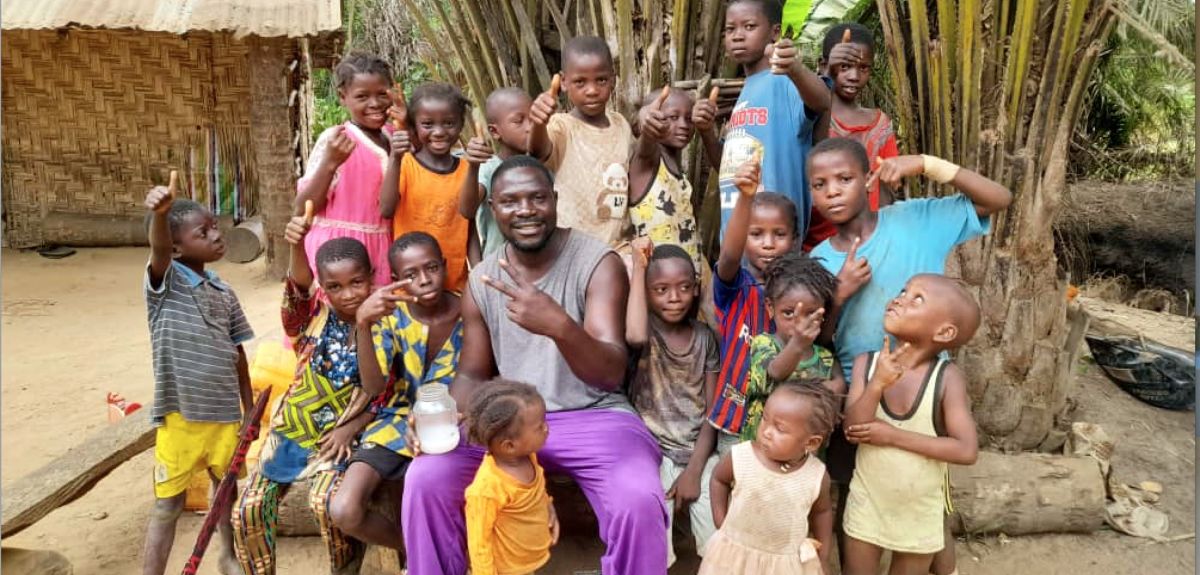
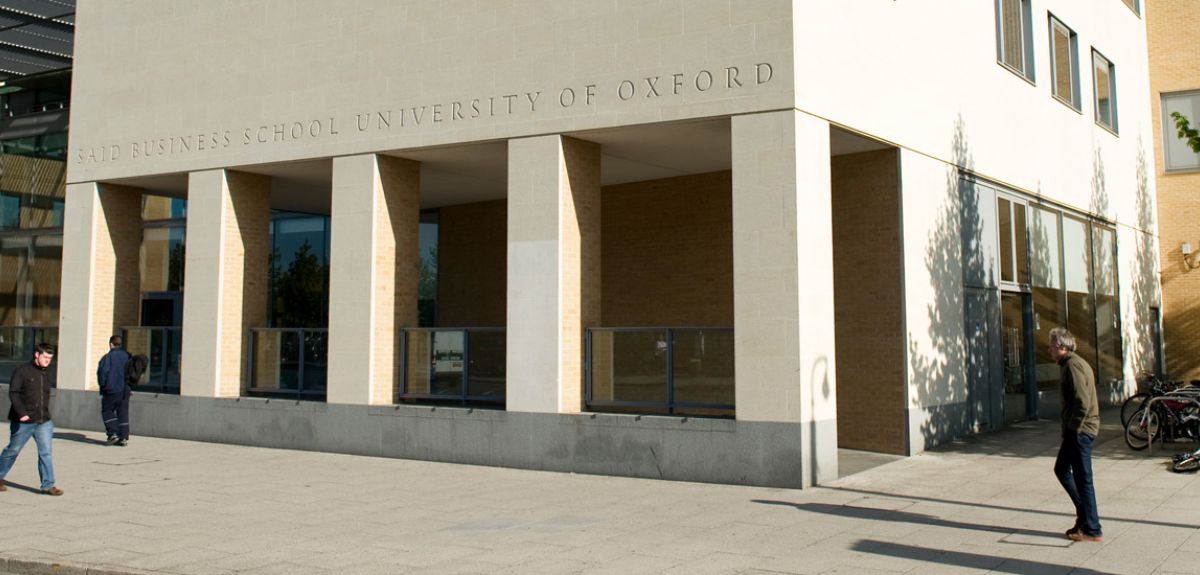
 From health policies to clinical practice, research on mental and brain health influences many areas of public life
From health policies to clinical practice, research on mental and brain health influences many areas of public life From research to action: How the Young Lives project is helping to protect girls from child marriage
From research to action: How the Young Lives project is helping to protect girls from child marriage  Can we truly align AI with human values? - Q&A with Brian Christian
Can we truly align AI with human values? - Q&A with Brian Christian  Entering the quantum era
Entering the quantum era Can AI be a force for inclusion?
Can AI be a force for inclusion? AI, automation in the home and its impact on women
AI, automation in the home and its impact on women Inside an Oxford tutorial at the Museum of Natural History
Inside an Oxford tutorial at the Museum of Natural History  Oxford spinout Brainomix is revolutionising stroke care through AI
Oxford spinout Brainomix is revolutionising stroke care through AI Oxford’s first Astrophoria Foundation Year students share their experiences
Oxford’s first Astrophoria Foundation Year students share their experiences DPhil student, Frankco Harris, reflects on his unique journey to Oxford and future plans
DPhil student, Frankco Harris, reflects on his unique journey to Oxford and future plans